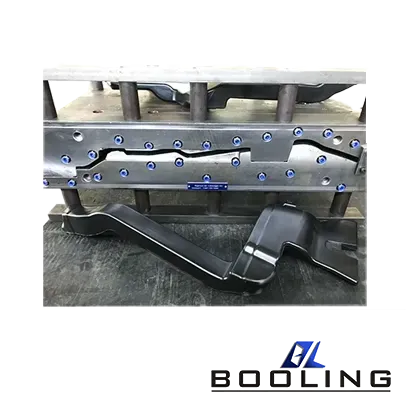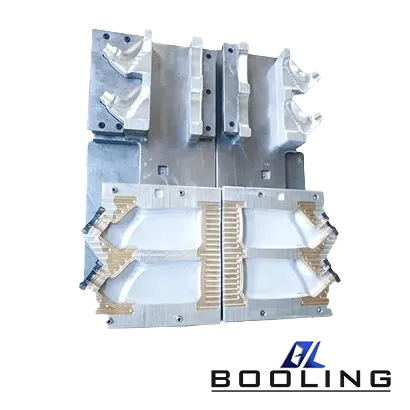Home > Extrusion Blow Moulding
Plastic Blow Molding
The mold design and production used in plastic blow molding method are simple and cost-effective. Compared with injection molding, blow molding can form complex and irregular shaped products with large internal space in one go, and achieve better aesthetics.

Extrusion Blow Moulding
The products produced by extrusion blow moulding have high precision, smooth surface, and outstanding advantages and manufacturers usually apply extrusion blow moulding to the production of pipes, medical equipment, and agriculture. The principle of extrusion plastic blow molding, also known as extrusion hollow blow molding, is to plasticize the melted plastic, enter the tubular machine head, and then send the formed blank that has been extruded to a certain length into the blow molding mold. With the help of gas pressure, the blank is blown to expand and tightly adhere to the mold wall. After it cools and forms, the mold is opened and demolded to obtain hollow blow-molded products.

Design Requirements for Extrusion Blow Moulding
During extrusion blow moulding and even the entire hollow blow molding process, certain design requirements need to be followed to ensure that the designed product meets the accuracy and quality requirements. Regardless of the type of blow-molded product, the following points must be met:
- While achieving optimal performance (such as good insulation, strength, accuracy, chemical corrosion resistance, etc.), it is necessary to ensure that its structure is as simple as possible, in line with user habits and ergonomics.
- The design process and process should be as simple as possible, avoiding the need for manual trimming after demoulding to reduce manufacturing and labor costs.
- Beautify daily necessities and children’s products based on their appearance to attract more such users.
- When designing, consideration should be given to the actual situation and needs, and the precision and quality level of the designed products should be improved as much as possible based on the manufacturing experience and learning level of the factory and employees.
- It should be noted that the properties of extrusion blow moulding need to be considered in the design. This blow molding method usually operates in a wet state, and the possibility of uneven thickness should be avoided in the design.

Material Selection of Extrusion Blow Moulding Molds
The production of extrusion blow moulding molds must ensure that they have a longer service life and a faster cycle mechanism, which is also required by modern industry. Therefore, the selection of mold materials is crucial. Choosing the right materials can bring good economic benefits and cost-effectiveness to manufacturers. The materials that can be used to make blow molding molds mainly include cast iron, stainless steel, aluminum alloy, copper alloy, zinc alloy, silicone rubber, engineering plastics, and polymer materials. How manufacturers choose materials mainly includes the following aspects:
- Steel
The application of steel in extrusion blow moulding molds is quite extensive, and its toughness and strength are far stronger than other materials. Manufacturers who need to produce large quantities of products often choose steel as the raw material. The molds made from this raw material have superior chemical resistance and corrosion resistance, long service life, and high precision and quality of the products produced. The surface treatment of the products made from molds made from this raw material is also relatively smooth. But for manufacturers with small product budgets, low precision requirements, and small manufacturing batches, rarely use and do not need to use this raw material because its manufacturing cost is much higher than other materials.
- Aluminum Alloy
Aluminum alloy is almost the most widely used non-ferrous metal in the industrial field, second only to steel in terms of usage. It is lightweight but high-density, therefore it has good strength and properties similar to steel, but its price is lower than steel. However, aluminum alloy is not more durable than steel. Therefore, aluminum alloy is suitable for manufacturers with small product budgets, low precision requirements, and small manufacturing batches. It can be used to make low-pressure casting molds, etc.
- Copper
The use of copper can be traced back to ancient times and is one of the few natural metals that can be produced in large quantities. Copper is closely related to human life and has certain applications in aerospace, electronics, and medical fields. Copper has good thermal conductivity. If advanced mold materials with precision and smooth surfaces need to be processed, copper is very suitable. However, mold products made from copper as raw material will inevitably have a very high cost, so copper is not suitable for large-scale production.
- Zinc Alloy
Zinc alloy has good fluidity, and is easy to weld, process, and recycle in mold manufacturing. Therefore, the cost of zinc alloy products is relatively low, but its high-temperature resistance is weak, and the dimensional accuracy is prone to change at a certain temperature. Therefore, molds made from zinc alloy as raw material are suitable for manufacturing products with low precision requirements and purifying them into steel before use.
- Silicone Rubber
Silicone rubber has good high-temperature resistance, strong plasticity, high tension, and good chemical resistance. Silicone rubber is widely used in the medical field, so molds made from silicone rubber are suitable for the production of medical equipment molds.
- Engineering Plastics
In recent years, the development trend of engineering plastics has been strong. Compared with ordinary plastics, they have excellent corrosion resistance, oxidation resistance, mechanical strength, and high-temperature resistance. There has gradually been a trend to replace non-ferrous metal processing. The molds produced by them are widely used in fields such as household appliances, electronics, automobiles, and chemicals. The production range of molds made from it is more extensive, and the accuracy and quality level are also comparable to steel.

Precautions for Using Extrusion Blow Moulding Molds
Extrusion blow moulding molds often require high costs, so manufacturers need to regularly maintain and upkeep them to reduce the risk of failure and equipment depreciation ratio, to improve cost-effectiveness. This requires certain usage precautions for users.
- Installation of Extrusion Blow Moulding Molds
Squeeze blow molding molds come in various models, so the installation methods and processes are also different. During installation, it is necessary to follow the correct process to ensure the safety of personnel and prevent damage to molds and equipment, to avoid maintenance and increase costs. After installation, the mold should be fixed promptly, and the personnel who fix the mold should take protective measures to ensure their safety.
- Debugging of Extrusion Blow MouldingMolds
When debugging the mold, it is important to be as careful as possible to prevent any future problems. At the same time, it is necessary to ensure that the products produced during the debugging process meet the accuracy and quality requirements. If they do not meet the requirements, designers, and operators need to jointly identify the cause and correct it promptly to prevent the occurrence of waste and noncompliant products in the future, increasing the risk of rework.
- Polishing and Lubrication of Extrusion Blow Moulding Molds
-Polishing
A well-used mold surface should present a mirror-like smooth state. If the molding cavity of the mold is uneven or rough, the mold needs to be polished. When polishing, a certain amount of polishing agent needs to be added to the mold and rubbed with a polishing cotton cloth until the mold returns to a smooth state before it can be put back into use.
-Lubrication
Even if a blow molding mold is in good use, it should be lubricated regularly. Both blow molding and injection molding require cyclic and intermittent mold opening and removal. Failure to add lubricating oil promptly can accelerate mold wear. So in the daily operation process, it is necessary to check for impurities in the lubricating oil and add lubricating oil in a timely and sufficient amount to ensure the normal use of the mold and blow molding machine.
- Component Maintenance of Extrusion Blow Moulding Molds
Firstly, the clamping mouth of the extrusion blow moulding mold often cuts off the edge of the mold material, so the wear is very serious. It is necessary to regularly check its wear situation. If the wear is severe, it needs to be replaced. The intake rods, guide pillars, etc. in the mold also need to be regularly inspected due to frequent mold opening. If there is wear, a certain amount of lubricating oil needs to be added. If it is very serious, maintenance or replacement should be carried out according to its severity. The cooling system of a mold is extremely critical in a mold, as it is susceptible to damage, leading to the inability of the mold to cool and solidify, and even causing warping, which affects the demolding of finished plastic parts. Therefore, regular inspections by mold operators or maintenance personnel are required.
- Storage of Extrusion Blow Molding Molds
If the extrusion blow moulding mold is not used for a long time, it should be thoroughly cleaned after the last use. It is best to cover the surface with a protective film or dust cover and store it in a dry, ventilated, and temperature-appropriate environment to prevent corrosion or changes in dimensional accuracy.
- Maintenance and Replacement of Extrusion Blow Moulding Molds
Squeeze blow molding molds require regular maintenance, such as 3 to 6 months, 12 months, or 36 months. The maintenance of molds includes the maintenance of feeding systems, discharging systems, working oil tanks, water inlet systems, cooling systems, and hydraulic systems, as well as some parts that are estimated to have reached their service life limit. The choice of repair or replacement is determined based on the severity of the damage.
Related News
Applied’s expertise in modifying materials at atomic levels and on an ihdustrial scaleenables our customers to transform possibilities into reality.



